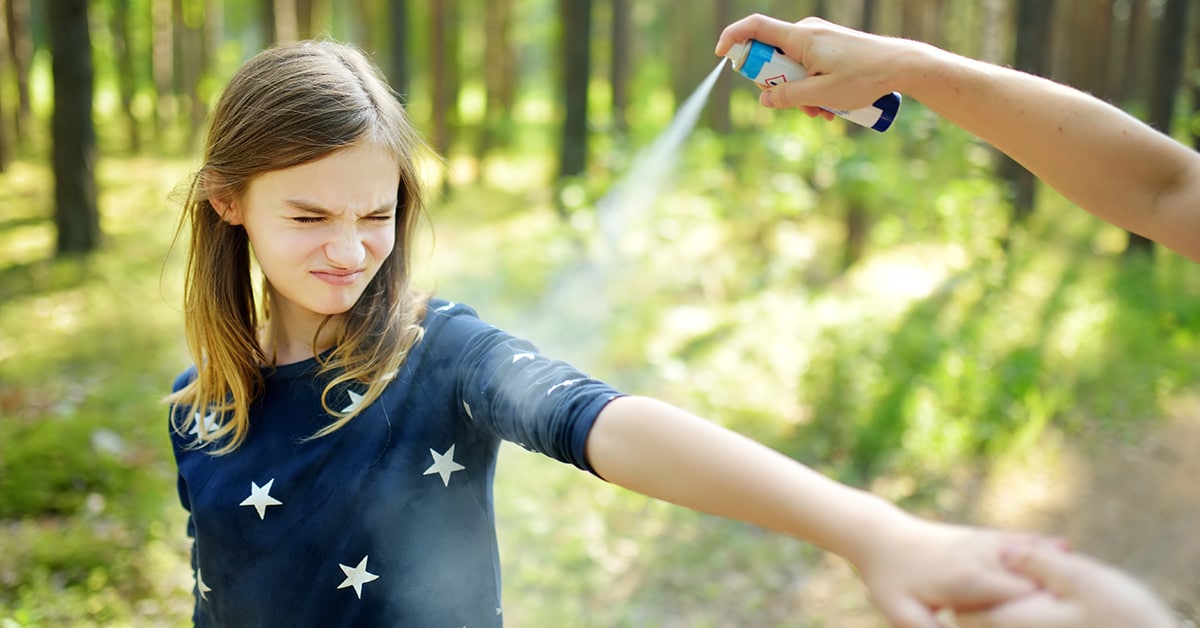
Tell Those Pests to “Buzz Off!”: Our Best Tips and Advice for Insect Bites and Stings
Many of us take the opportunity to enjoy more time outdoors during these long summer days. However, an irritating insect bite or sting can put a damper on an otherwise lovely day of play. When an insect, such as a mosquito, flea, or tick uses its mouth to break the skin, it’s usually so it can feed. Insect bites often itch, this guide provided by the American Academy of Pediatrics helps identify them. Other insects, like wasps, may use a barbed stinger at their tail end, to pierce the skin and inject venom. Stings are usually inflicted in self-defense and are typically more painful than bites. Most stings and bites are harmless albeit uncomfortable, however, there are instances in which serious health problems can occur.
Mosquito Bites
Have you heard the joke about Alabama’s state bird being the mosquito? Well, there is some truth in comedy. The abundance of watery marshes, forests, and tall grasses across the southeast provide a welcoming habitat for mosquitos. Common signs of a mosquito bite may be familiar, they include:
- A puffy and reddish bump appearing a few minutes after the bite
- A hard, itchy, reddish-brown bump, or multiple bumps appearing a day or so after the bite or bites
- Small blisters instead of hard bumps
- Dark spots that look like bruises
More severe reactions may present in the following ways:
- A large area of swelling and redness
- Low-grade fever
- Hives
- Swollen lymph nodes
The temptation to scratch an itchy bite is inevitable, but it can lead to infection. The following steps should be taken to treat your little one’s bite:
- Wash the area with soap and water.
- Apply an ice pack for 10 minutes to reduce swelling and itching. Reapply ice pack as needed.
- Apply a mixture of baking soda and water, which can help reduce the itch response.
- Apply an antiallergic cream to reduce itchiness, or mix 1 tablespoon baking soda with just enough water to create a paste. Apply the paste to the mosquito bite, wait 10 minutes then wash to remove the paste.
It is important to remember that there are a few types of mosquitos that carry mosquito-borne diseases; West Nile Virus is the disease most commonly found in mosquitos in Alabama, Louisiana, and Tennessee. West Nile infections are often asymptomatic, however, about one in five people will develop a fever and other symptoms such as headache, body aches, joint pains, vomiting, diarrhea, rash, or fatigue. If your child exhibits any of these concerning signs, see your child’s primary care provider for testing and treatment.
Tick Bites
Ticks are tiny so they can be hard to see and tricky to remove their bites are painless and will often go unnoticed. Therefore, it is a good idea to check your child for ticks when playing in areas with high grass or forests. If you’re unfamiliar with ticks refer to this image guide. Most tick bites are harmless. However, wood ticks can sometimes pass on Rocky Mountain spotted fever or Colorado tick fever and deer ticks can sometimes pass on Lyme disease. If you find a tick on your child, please remain calm and take the following steps recommended by the American Academy of Pediatrics to remove ticks:
- While holding tweezers sideways next to the skin’s surface, grasp the tick on its head.
- Pull the tick straight upward without twisting or crushing it.
- Maintain a steady pressure until it releases its grip.
- If your child has a smaller deer tick on them, use a credit card to scrape it off. If the deer tick is engorged, you may attempt to use tweezers to remove it.
- After removing a tick, wash the wound and your hands with soap and water; this helps to decrease the likelihood of catching any disease carried by the tick.
- You can also apply a topical antibiotic ointment such as Polysporin. No prescription is needed, apply it to the bite once.
- Keep an eye on the affected area, if any disease is present, a rash will appear within two to four weeks.
Should you accidentally break the tick’s head, attempt to remove it safely by taking these measures:
- Cleanse the skin with rubbing alcohol.
- Use clean tweezers or a needle to uncover the head and scrape it off.
- Note that if a small piece of the head remains, the skin will slowly shed it.
- Visit your pediatric provider if: You tried and can’t remove the tick, fever or rash happens in the next two to four weeks or the bite starts to look infected.
Insect Stings
Wasps, bees, and other insects can pack a powerful sting. In children who are not allergic to stings, redness and swelling of the area might occur for up to a week. Other mild reactions could also include sneezing, an itchy nose, and mouth, a few hives, or a stomachache. If your child is stung by a bee, carefully remove the stinger as soon as possible. The American Academy of Pediatrics notes that the stinger continues to release venom, which causes itching and pain. The AAP recommends that you remove the stinger and treat irritation in this way:
Look for a black dot in the center of the sting area. Scrape it out with a credit card or try peeling it off with a piece of sticky tape. If part of the stinger stays under the skin, it’s OK to leave it alone. Rub an aluminum-based deodorant or a baking soda paste on the sting to neutralize the venom. If the pain continues, use a cold pack or ice cube. Sometimes, over-the-counter steroid cream (e.g., 1% hydrocortisone) and antihistamines (e.g., diphenhydramine) help. If symptoms do not go away on their own or your child was stung multiple times, check with your child’s pediatrician.
When a child is allergic to insect stings, the symptoms are much more concerning:
- Shortness of breath
- Wheezing
- Coughing
- Paling skin
- Weak pulse
- Fainting
- Tight throat
- Trouble breathing
- Swelling of the lips or tongue that affects breathing
- Hives
- Confusion
Children with severe allergic reactions should be given epinephrine, and 911 should be called immediately afterward.
Take Precaution
Try as we might, we can’t protect our children from everything. Yet, taking these simple steps can help lessen the instance of summer insect bites and stings.
- Apply insect repellant to exposed skin and clothing before playing outside. The American Academy of Pediatrics (AAP) recommends that repellents only be used on children over two months old, and the product should contain no more than 30 percent DEET when used on children.
- To apply repellent to your child’s face, spray on your hands and then rub gently, avoiding their eyes.
- Wear long-sleeved shirts and pants when outdoors for long periods
- Avoid perfumes and colognes when outdoors for extended periods.
To discourage pesky insects from entering your home, make sure that your living space has tight-fitting windows and doors, and that all screens are free of holes. Try to keep your home free of standing water, which is where mosquitoes breed. Turn over wheelbarrows, plastic wading pools, buckets, trash cans, children’s toys, or anything that could collect water. Keep rain gutters clean to minimize flying insects breeding. Insects are a necessary part of our ecosystem, but these pests don’t need to spoil your family’s fun. Take some simple precautions to protect your little ones, and be prepared. Should your child experience a sting or bite this summer, Urgent Care for Children’s dedicated providers are happy to screen your little one in any of our 17 convenient locations across Alabama, Tennessee, and Louisiana.



